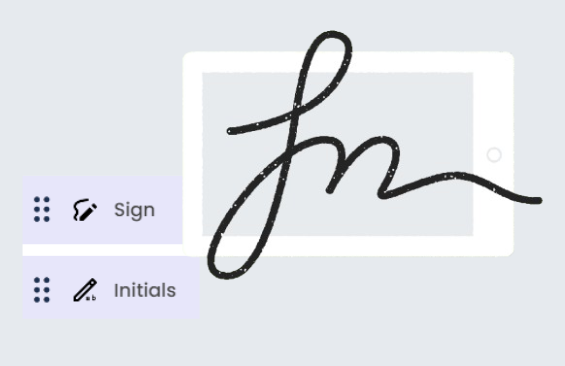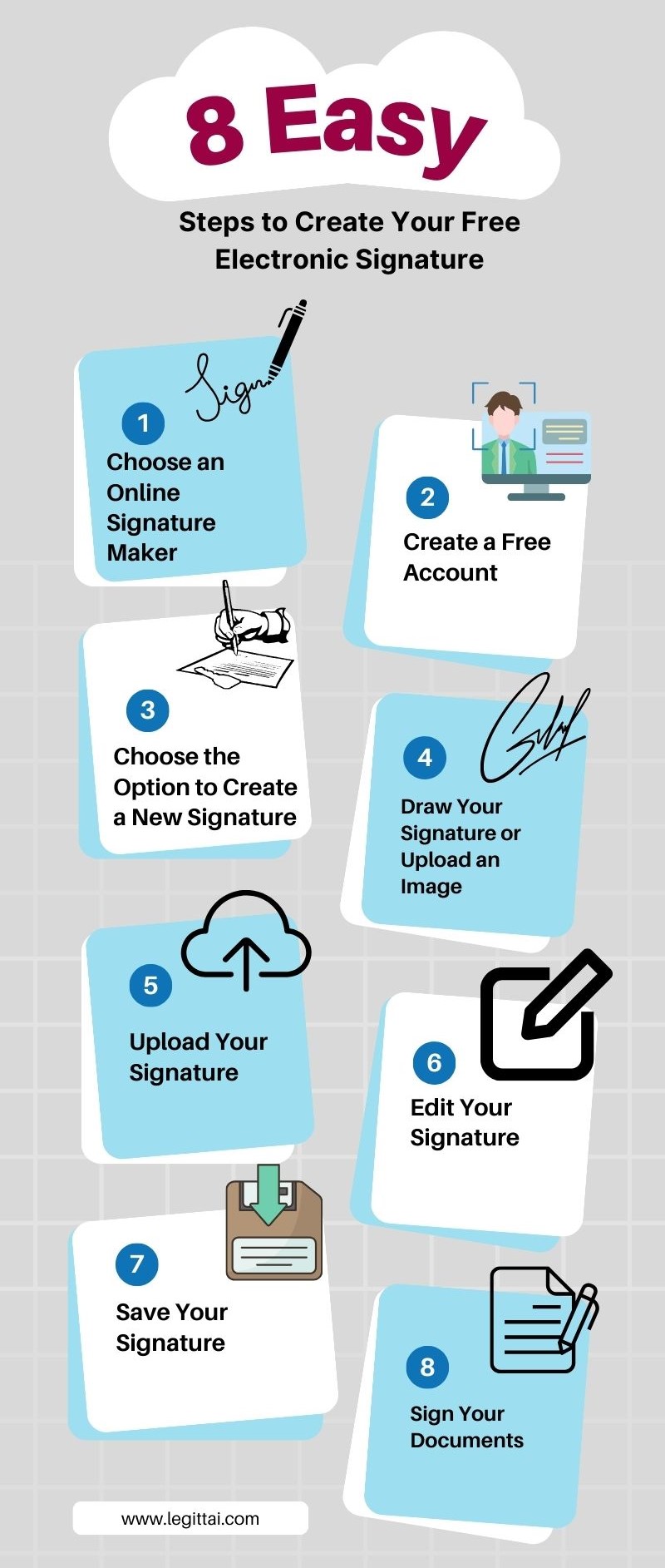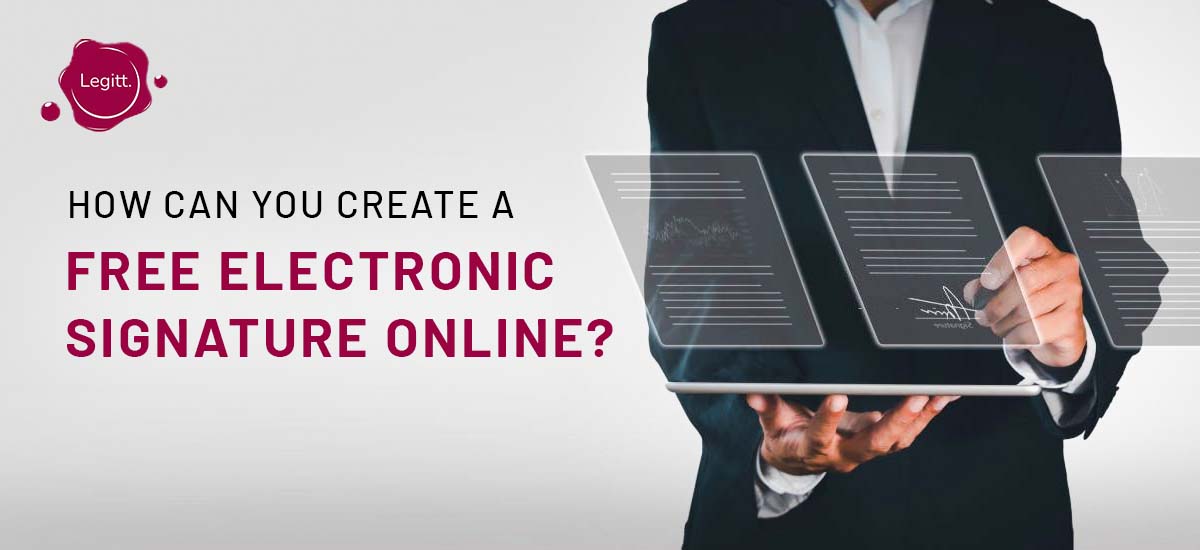Electronic signatures have become a popular method of signing documents in today’s digital world. They offer convenience, security, and efficiency, making it easier for individuals and businesses to complete transactions and agreements quickly and easily. In this post, we will define electronic signatures and provide a step-by-step guide on how to do an electronic signature for free.
What’s inside?
- What is an Electronic Signature?
- How to Create an Electronic Signature for Free?
- Why Use an Electronic Signature?
- Conclusion
What is an Electronic Signature?
An electronic signature, also known as an e-signature, is a digital method used to create electronic signatures on documents—without the need to print or scan. It offers a legally recognized way to show agreement or approval, streamlining workflows across industries.
There are many ways to apply an electronic signature free of charge, making it easier than ever to sign contracts, forms, or approvals remotely. Whether you’re a freelancer, business owner, or part of a legal or HR team, using an e signature free tool can help you save time and stay organized.
Common types of electronic signatures include
- Typed Name or Initials: A quick and simple way to create electronic signatures by entering your name or initials in a chosen font.
- Scanned Signature Image: Upload an image of your handwritten signature and place it directly into your document.
- Drawn Signature: Use a mouse, stylus, touchpad, or touchscreen to draw your signature manually, which gives a more personal touch.
When using a platform that offers an electronic signature free, your signed documents can also be enhanced with additional security measures like timestamping, IP tracking, and email verification-helping to ensure the integrity and legal standing of your agreements.
Generate Your Electronic Signature Instantly
Make your Electronic Signature in minutes using Legitt AI.
Try Making Your Signature
Legality of Electronic Signatures
Electronic signatures are legally binding and recognized by most countries around the world. Laws such as the ESIGN Act (USA) and eIDAS Regulation (EU) ensure that e-signatures hold the same validity as handwritten signatures. Additionally, e-signatures offer several advantages over traditional pen-and-paper signatures, such as:
- Seamless integration with online workflows and cloud storage
- Enhanced security with encryption and digital authentication
- Increased efficiency by eliminating manual paperwork
Also Read: What is contract management software
How to Create an Electronic Signature for Free?
Creating electronic signatures is easy and can be done for free using a variety of esignature online tools. Here is a step-by-step guide on how to create digital signature for free:

Step 1: Choose an Online Signature Maker
There are several online esignature makers available, such as DocuSign, HelloSign or Legitt. Choose one that offers a free plan that meets your needs.
Step 2: Create a Free Account
Register for a free account on the online signature maker’s website. You can sign up using your Google or Facebook account, or by creating a new account using your email address.
Step 3: Choose the Option to Create a New Signature
Once you’ve signed in, choose the option to create a new signature.
Step 4: Draw Your Signature or Upload an Image
You can either draw your signature using your touchpad or mouse, or upload an image of your signature. If you choose to draw your signature, use your touchpad or mouse to draw your signature on the screen. If you choose to upload an image, scan a copy of your signature or take a photo of it using your phone and save the image to your computer.
Step 5: Upload Your Signature
Upload the image of your signature to the online signature maker.
Step 6: Edit Your Signature
Edit your signature if necessary. You can change the color, size, and font of your signature to suit your preferences.
Step 7: Save Your Signature
Save your signature to your account.
Step 8: Sign Your Documents
You can now use your electronic signature to sign documents online. Simply upload the document to the online signature maker, add your signature, and save the signed document to your computer.
Also Read: How to Sign a PDF Document
Why Use an Electronic Signature?
Now that you understand how to create an electronic signature for free, it’s important to recognize why e-signatures are increasingly becoming the preferred method of signing documents over traditional handwritten signatures. Here are some detailed reasons to make the switch:
- Convenience: Convenience is one of the primary advantages tied to e-signatures. Old-world signatures need printing, writing, and scanning or mailing back to the other party, which consumes so much time. E-signatures can operate directly through your computer or mobile device from any point in the globe, at any time. There is no need to wait for documents to appear through the mail or schedule a time to meet in person. This would be particularly convenient for a lending firm or an individual with thousands of contracts and documents he/she has to juggle every day, as it significantly reduced the time required in signing these or the administrative duties bound up in it.
- Security: Compared to traditional handwritten signatures, e-signatures offer a superior level of security. When your signature is incorporated digitally, it gets encrypted and set in the document itself, thereby restraining unauthorized individuals from tampering with it. Audit trail is also one of the important features offered by many e-signature platforms that includes data related to who signed the document, when it was signed, and from which ip address. This evidence provides a verifiable record of the signing process to guarantee that each signature can be traced and is legitimate. Unlike physical signatures, which may be easily forged or altered without a trace, e-signatures provide added protection against fraud and tampering of documents.
- Cost-Efficiency: The actual making cost is lowered significantly through the use of e-signatures. There is an entire physical procedure that requires charges for printing, paper, ink, postage, and courier services when one uses a physical signature. Such a situation can quickly take up costs when the company sends or receives a lot of documents. E-signatures free businesses from the mundane and not-so-easy process of printing and managing piles of paper, ink, and postage, saving them from far much higher costs. Besides that, lesser physical space is used for housing signed documents, which translates to lesser overheads for the businesses. This became green also through reducing documents piling and disposing of paper. That’s right, e-signatures are just the right thing for green practices.
- Speed and Efficiency: Traditional document signing has long delays in the time between receiving a document, signing it, and returning it. This time often poses frustration for both parties involved and slows the speed of doing business. E-signatures speed this process up considerably, allowing documents to be signed and sent back in as few clicks as possible. This fast turnaround is particularly crucial for high-stakes transactions or teal agreements, where an hour’s delay can result in lost opportunities. E-signature documents can be signed in minutes and enrich overall workflow efficiency.
- Global Accessibility: Traditional signatures often require physical presence making them impracticable for international transactional dealings or distance agreements. All distance barriers are nullified by e-signatures. You can send to or sign documents with anyone across the globe, regardless of their location, and still have a legally binding contract. This global accessibility enables businesses to extend their scope and makes cross-border transactions much easier. Whether you’re in the United States, you’re in Europe, or Asia, you’ll find effective e-signatures without the tedious need for travel or international mailing.
- Improved Document Management: Managing physical documents, especially signed ones, can be a logistical nightmare. You need to store, organize, and ensure the safety of each document. With e-signatures, documents are stored securely in digital formats that are easy to organize and access. Cloud-based e-signature platforms typically provide searchable, secure repositories where signed documents are automatically stored and can be retrieved with just a few clicks. This improved document management saves time and reduces the chances of losing important signed paperwork. Moreover, digital files are easier to share, update, and collaborate on, further enhancing business efficiency.
- User-Friendly and Customizable: E-signature tools are designed to be user-friendly, with intuitive interfaces that make signing documents simple for anyone, regardless of their technical proficiency. Whether you’re a business owner, freelancer, or consumer, you can easily create, store, and apply your e-signature to documents without requiring any specialized knowledge. Many e-signature platforms also allow you to customize your signature by selecting different fonts, colors, or styles to match your personal or corporate brand. This flexibility ensures that your e-signature looks professional and can be adapted to fit various document formats.
- Transparency and Trust: The signing process becomes increasingly transparent with e-sign signatures because one knows who signed the document and when it was made. This will help in building trust amongst the concerned parties in a transaction as it becomes substantiated with clear proof of consent and agreement. Moreover, with e-signature platforms, there are generally certificates of completion, as well as other records of verifiable fact, that strengthen the signature’s authenticity. This will be most relevant in business dealings that include important concepts like trust and accountability that are very crucial for forging strong relationships with clients, partners, and stakeholders.
- Better Customer Experience: For businesses, offering an e-signature solution can improve the overall customer experience. Traditional signing methods can often feel cumbersome and inconvenient for clients, leading to frustration and delays. On the other hand, e-signatures provide a smooth, quick, and efficient way for customers to sign documents at their convenience. Whether it’s a sales agreement, service contract, or any other document, customers will appreciate the ease of digitally signing documents from their computers or mobile devices, making it more likely for them to complete the transaction quickly.
How to Choose the Right Electronic Signature for Your Business
Selecting the right electronic signature solution is essential for ensuring legal compliance, security, and scalability in business operations. Several key factors influence this decision:
- Compliance Requirements: Businesses operating in highly regulated industries such as finance, healthcare, and real estate must comply with strict legal frameworks. Regulatory bodies like the eIDAS in the EU, ESIGN Act in the U.S., and HIPAA for healthcare mandate specific standards for electronic signatures. In such cases, adopting a qualified electronic signature (QES) ensures the highest level of legal validity and compliance.
- Security Considerations: When dealing with sensitive business agreements, contracts, or financial transactions, security becomes a top priority. Advanced electronic signature solutions offer features like encryption, audit trails, multi-factor authentication (MFA), and biometric verification to prevent unauthorized access and document tampering. Businesses handling confidential client data should choose solutions that provide robust security mechanisms.
- Cost and Scalability: For startups and small businesses, affordability is a critical factor. Basic electronic signatures provide a cost-effective entry point, allowing companies to digitize contract signing without significant investment. However, as businesses grow, they may require solutions that offer workflow automation, integrations with CRM and contract management systems, bulk signing capabilities, and enterprise-wide security controls. Choosing a scalable solution ensures smooth expansion without disrupting operations.
By evaluating compliance needs, security standards, and long-term scalability, businesses can select an electronic signature solution that aligns with their operational goals and industry requirements.
Conclusion
Creating an electronic signature for free is a simple and straightforward process that offers many benefits, from increased convenience to enhanced security. By following the steps outlined in this guide, you can easily create and use an electronic signature to sign documents quickly and legally. Whether you’re signing contracts, agreements, or forms, e-signatures are a valuable tool that can streamline your workflow and save you time and money. So, if you’ve been wondering how to create an electronic signature for free, now you have the knowledge to get started. Happy signing!
Did you find this article worthwhile? More engaging blogs about smart contracts on the blockchain, contract management software and electronic signatures can be found in the Legitt Blogs section. You may also contact Legitt to hire the best contract lifecycle management services and solutions.
FAQs on How to do an Electronic Signature
What is electronic signature and its types?
An electronic signature is a digital representation of a person's handwritten signature, used to sign documents in a secure and efficient manner. There are several types of electronic signatures, including simple electronic signatures, advanced electronic signatures, and qualified electronic signatures. A simple electronic signature is a basic electronic signature that uses a person's name or initials, while an advanced electronic signature uses additional security measures, such as encryption or biometrics, to ensure the signature's authenticity. A qualified electronic signature is a type of advanced electronic signature that is legally recognized as equivalent to a handwritten signature.
What is the difference between electronic signature and digital signature?
The main difference between electronic signature and digital signature is the level of security and authenticity they provide. Electronic signatures are a type of digital signature that represent a person's handwritten signature, while digital signatures use encryption and other security measures to ensure the integrity of a document. Digital signatures are often used for more sensitive transactions where security and legal validity are of the utmost importance, while electronic signatures are more commonly used for less critical documents.
Can electronic signature be handwritten?
Yes, an electronic signature can be handwritten using a touchpad, mouse, or stylus on a digital device. This method is often used to create a digital version of a person's handwritten signature, which can then be used to sign documents electronically in a secure and efficient manner.
Where all electronic signatures are used?
Electronic signatures are used in a wide range of industries and applications, including finance, healthcare, government, and legal services. They are commonly used to sign contracts, agreements, and other legal documents, as well as for remote identity verification and authentication. Electronic signatures are also used in e-commerce transactions and to sign and submit tax forms and other government documents.
Is electronic signature valid?
Yes, electronic signatures are legally valid and binding in most countries around the world. The legal validity of an electronic signature depends on several factors, such as the type of signature used, the identity of the signer, and the nature of the transaction or document being signed. However, in general, electronic signatures offer the same legal validity as traditional pen and paper signatures, and are recognized by courts and other legal authorities.
Is a scanned signature an electronic signature?
Yes, a scanned signature can be considered an electronic signature. A scanned signature is a digital image of a person's handwritten signature that can be added to electronic documents to serve as a signature. While a scanned signature is not as secure or authentic as other types of electronic signatures that use encryption or biometrics, it can still be legally binding and accepted in many situations. However, it is important to ensure that the scanned signature is of high quality and cannot be easily altered or forged.
What makes an eSignature legal?
Several factors contribute to making an eSignature legally binding, including the identity of the signer, the intent to sign, and the authenticity and integrity of the signed document. To ensure legal validity, it is essential that the eSignature solution used provides sufficient security measures and complies with applicable laws and regulations, such as the Electronic Signatures in Global and National Commerce (ESIGN) Act in the United States or the eIDAS Regulation in the European Union.
Can we create electronic signature in Word?
Yes, you can insert an electronic signature in a Word document. One way to do this is to create a digital image of your signature and insert it as an image into the Word document. Alternatively, you can use a specialized eSignature software or add-in that integrates with Word and allows you to sign documents electronically. Some eSignature solutions like Legitt also offer the ability to create and sign documents directly within the Word interface, making the process even more streamlined and efficient.
